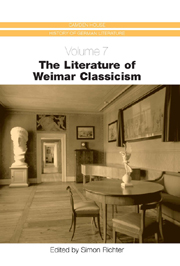Book contents
- Frontmatter
- Contents
- List of Illustrations
- Preface and Acknowledgments
- Conventions, Editions, and Abbreviations
- Introduction
- What is Classicism?
- Antiquity and Weimar Classicism
- The Correspondents' Noncorrespondence: Goethe, Schiller and the Briefwechsel
- Johann Gottfried Herder: The Weimar Classic Back of the (City)Church
- Drama and Theatrical Practice in Weimar Classicism
- German Classical Poetry
- The Novel in Weimar Classicism: Symbolic Form and Symbolic Pregnance
- German Women Writers and Classicism
- Weimar Classicism as Visual Culture
- The Irrelevance of Aesthetics and the De-Theorizing of the Self in “Classical” Weimar
- Goethe's “Classical” Science
- The Political Context of Weimar Classicism
- Bibliography
- Notes on the Contributors
- Index
What is Classicism?
Published online by Cambridge University Press: 05 February 2013
- Frontmatter
- Contents
- List of Illustrations
- Preface and Acknowledgments
- Conventions, Editions, and Abbreviations
- Introduction
- What is Classicism?
- Antiquity and Weimar Classicism
- The Correspondents' Noncorrespondence: Goethe, Schiller and the Briefwechsel
- Johann Gottfried Herder: The Weimar Classic Back of the (City)Church
- Drama and Theatrical Practice in Weimar Classicism
- German Classical Poetry
- The Novel in Weimar Classicism: Symbolic Form and Symbolic Pregnance
- German Women Writers and Classicism
- Weimar Classicism as Visual Culture
- The Irrelevance of Aesthetics and the De-Theorizing of the Self in “Classical” Weimar
- Goethe's “Classical” Science
- The Political Context of Weimar Classicism
- Bibliography
- Notes on the Contributors
- Index
Summary
Are there German classics?” Nietzsche poses this question in the second volume of Human, All Too Human. He cites Charles Augustin Sainte-Beuves's (1804–69) essay “Qu'est-ce qu'un classique?” (What Is a Classic?) in the Causeries du lundi (Monday Lectures, 1851), where we read that “the word ‘classic’ does not suit the genius of certain literatures. For instance, nobody could talk seriously of ‘German classics.’ ” But that is precisely what happened with increasing frequency in Germany in the course of the nineteenth century. The concept of the classical was used in an inflationary manner. In Einen Jux will er sich machen (He Wants to Play a Joke, 1842), a comedy by Johannes Nepomuk Nestroy (1802–62), we find satirical confirmation of this observation. The dimwitted house servant Melchior finds everything “classical.” “Was hat er denn immer mit dem dummen Wort klassisch?” asks the principal Zangler brusquely (Why are you so obsessed with that dumb word classical?).
Melchior: Ah, das Wort is nit dumm, es wird oft dumm angewend't.
Zangler: Ja das hör’ ich, das muß er ablegen, ich begreif nicht, wie man in zwei Minuten 50mal dasselbe Wort repetieren kann.
Melchior: Ja, das ist klassisch.
[Melchior: Ah, the word is not dumb, but its application often is.
Zangler: Yes, I hear you, but you must stop, I just don't understand how one can repeat the same word fifty times in two minutes.
Melchior: Yes, that is classic.]
In the course of the nineteenth and twentieth centuries three distinct epochs in German literature came to be dubbed Klassik. The Middle High German cultural highpoint around 1200 is known as “Staufische [for Hohenstauffen] Klassik”; the literary works of Goethe and Schiller during their Weimar years (or rather a portion thereof) are known as “Weimarer Klassik”; and Viennese Classicism designates the pinnacle of European and German music: the epoch of Haydn, Mozart, and Beethoven. In the meantime, the concept of the classical and the classic is more debated now than ever before.
- Type
- Chapter
- Information
- The Literature of Weimar Classicism , pp. 45 - 62Publisher: Boydell & BrewerPrint publication year: 2005



